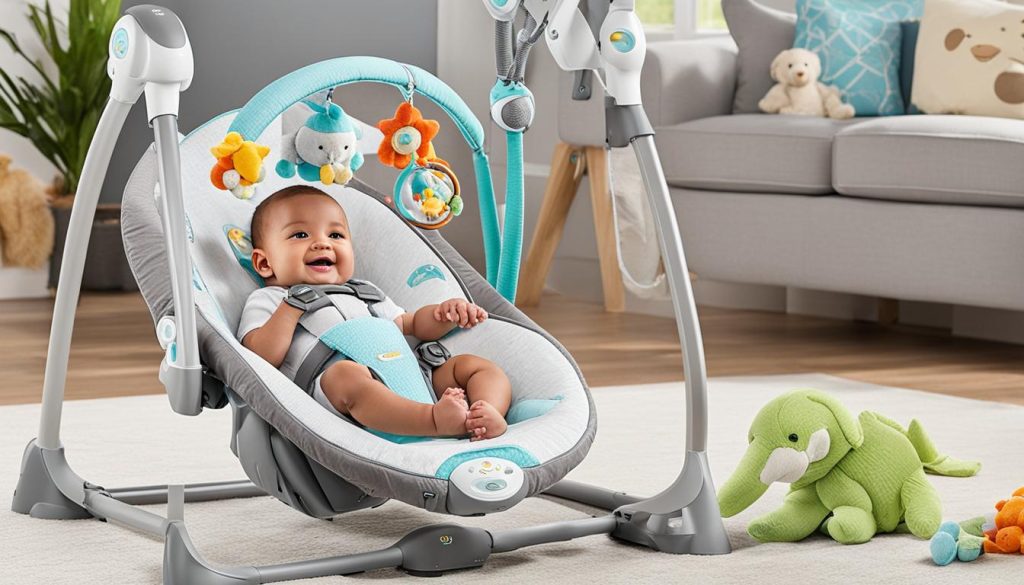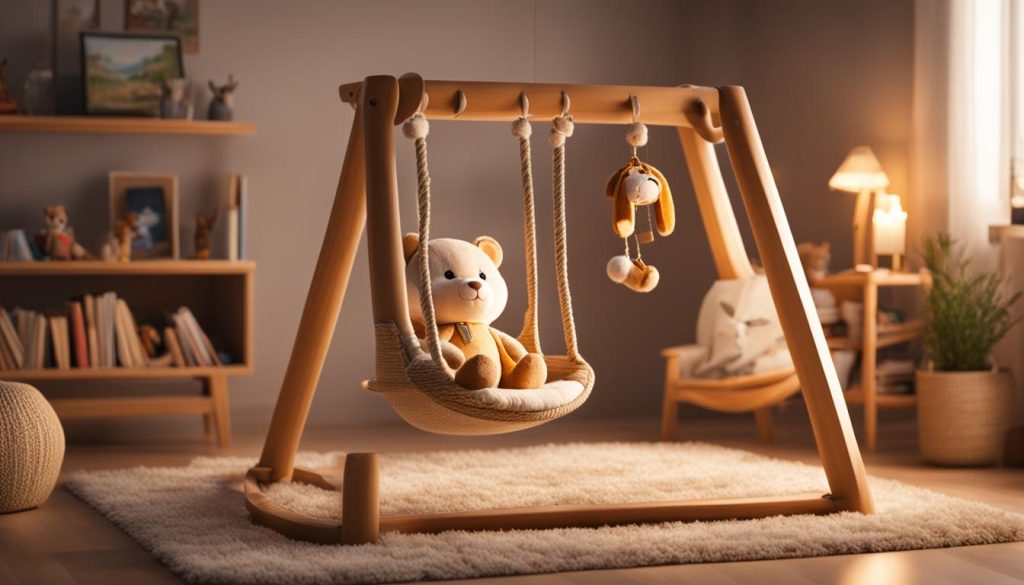Hanging a baby swing is a great way to soothe and entertain infants. However, not everyone has a suitable tree in their backyard to hang the swing from. In this article, I will explore innovative ways to hang a baby swing without a tree, providing alternative options for installation.
If you’re wondering how to hang a baby swing without a tree, or looking for hanging baby swing alternatives, you’ve come to the right place. Whether you have limited outdoor space or simply want to explore creative solutions, I’ll guide you through the process.
Let’s dive in and discover the various methods and considerations for hanging a baby swing without relying on a tree.
Considerations for Hanging a Baby Swing
When it comes to hanging a baby swing without a tree, there are several important considerations to keep in mind. Before making a decision on the installation method, take the time to evaluate the available options and assess your specific needs and circumstances.
If you don’t have access to outdoor space, it’s crucial to explore alternative methods to hang the baby swing indoors. This can include utilizing a swing set specifically designed for indoor use or exploring creative solutions such as using wall-mounted hooks or swing stands.
Additionally, safety should always be a top priority when hanging a baby swing. Ensure that the chosen method is sturdy and reliable, capable of bearing the weight of the swing and the baby. Follow the manufacturer’s installation instructions closely to ensure a secure setup.
Indoor Baby Swing Hanging Methods
If you’re considering hanging a baby swing indoors, there are several methods to choose from:
- Wall-mounted hooks: These hooks should be securely anchored into a load-bearing wall to provide a stable hanging point for the baby swing.
- Swing stands: These freestanding structures are specifically designed to support a baby swing indoors. They often have adjustable height options to accommodate different swing models.
- Doorway frame mounts: These mounts are designed to fit over the top of a doorway frame, providing a secure attachment point for the baby swing.
Remember to always prioritize safety when choosing an indoor baby swing hanging method. Follow the manufacturer’s instructions, ensure proper installation, and regularly inspect the hanging apparatus for any signs of wear or damage.
| Installation Method | Description |
|---|---|
| Wall-mounted hooks | Securely anchored hooks attached to a load-bearing wall to hang the baby swing indoors. |
| Swing stands | Freestanding structures designed to support a baby swing indoors, often adjustable in height. |
| Doorway frame mounts | Mounts that fit over the top of a doorway frame, providing a secure attachment point for the baby swing. |
Types of Baby Swings
When it comes to selecting a baby swing, there are various types available in the market. Understanding these options can help you make an informed decision that suits your baby’s needs and preferences. Let’s explore the different types of baby swings and the features they offer.
1. Full-Size Baby Swing: These swings are larger, providing a secure and comfortable space for your baby to relax and play. They often come with a wide range of features, including different motion types, adjustable seat positions, music, and toys. Full-size swings are suitable for both indoor and outdoor use.
2. Portable Baby Swing: If you’re frequently on the go or have limited space, a portable baby swing can be a great option. These compact swings are lightweight and can be easily folded and stored when not in use. Portable swings typically offer basic features and are designed to be easily transported.
3. Convertable Baby Swing: A convertible baby swing is a versatile option that can grow with your child. These swings can often be converted into a stationary seat or a toddler rocker, extending their usability beyond the infancy stage. Convertible swings are an excellent long-term investment.
4. Bouncer: While not technically swings, bouncers provide a similar soothing motion. They are smaller and more lightweight than traditional swings, making them easy to move around the house. Bouncers often feature gentle bouncing or vibrating motions to help calm your baby.
When choosing a baby swing, consider the safety features, such as secure harnesses and sturdy construction. Additionally, think about the motion types that your baby may find soothing, and the ease of use features that can make your life easier. Now that we’ve explored the different types of baby swings, let’s move on to the next section to discover creative DIY solutions for hanging a baby swing without a tree.
DIY Baby Swing Hanging Solutions
If you’re looking for creative ways to hang a baby swing without a tree, you’ll be pleased to know that there are several DIY solutions available. These options allow you to customize the installation process to suit your space and preferences. Here are a few ideas to get you started:
1. Build a Custom Swing Set
One option is to build a custom swing set specifically designed for your baby swing. This can be a fun and rewarding project that allows you to create a safe and secure structure in your backyard. Research different swing set plans online and choose one that fits your needs and skill level. Remember to follow all safety guidelines and ensure the swing set is sturdy and properly anchored.
2. Use Sturdy Hooks and Straps Indoors
If you prefer to hang the baby swing indoors, you can utilize sturdy hooks and straps to create a secure hanging solution. Look for hooks that are designed to hold heavy weights and ensure they are properly mounted into a stud or strong ceiling beam. Use durable straps that can support the weight of the swing and your baby, following the manufacturer’s guidelines for installation.
3. Repurpose Existing Structures
Another creative option is to repurpose existing structures in your home or backyard to hang the baby swing. This could include porches, pergolas, or even sturdy tree branches (if available). Ensure that the structure is strong enough to support the weight of the swing and your baby. Use appropriate hardware and straps to securely attach the swing, and always prioritize safety in your setup.
Remember, when implementing any DIY baby swing hanging solution, it’s crucial to prioritize safety and stability. Regularly check the installation for any signs of wear or weakness, and always supervise your baby while they are in the swing. With careful planning and consideration, you can create a safe and enjoyable space for your little one to swing and play.
Table: DIY Baby Swing Hanging Solutions
| Solution | Description |
|---|---|
| Build a Custom Swing Set | Create a customized swing set in your backyard that is specifically designed for your baby swing. |
| Use Sturdy Hooks and Straps Indoors | Hang the baby swing indoors using strong hooks and straps mounted into a stud or strong ceiling beam. |
| Repurpose Existing Structures | Utilize porches, pergolas, or sturdy tree branches (if available) to securely hang the baby swing. |
Indoor Baby Swing Hanging Methods
When it comes to hanging a baby swing indoors, safety is of utmost importance. There are several methods that can be used to securely install a baby swing without a tree. By following proper installation guidelines and considering the available options, parents can create a safe and enjoyable space for their little one.
One method for hanging a baby swing indoors is to use wall-mounted hooks. These hooks should be sturdy and properly anchored to bear the weight of both the swing and the baby. It is crucial to carefully follow the manufacturer’s instructions during installation to ensure a secure setup. Wall-mounted hooks provide a reliable solution for hanging a baby swing indoors, allowing parents to have peace of mind while their baby enjoys the gentle rocking motion.
Another option for indoor baby swing hanging is the use of swing stands. These stands are designed specifically for baby swings and provide a stable base for installation. Swing stands come in different sizes and designs, so it’s important to choose one that is compatible with the baby swing being used. They offer a convenient and secure way to hang a baby swing indoors, eliminating the need for a tree or any other external support.
Hanging a Baby Swing Indoors: Key Considerations
- Ensure wall-mounted hooks or swing stands are properly anchored and capable of bearing the weight of the swing and the baby.
- Follow the manufacturer’s installation instructions carefully to ensure a safe and secure setup.
- Regularly inspect the installation for any signs of wear or damage, and make necessary adjustments or repairs as needed.
- Keep the swing at a safe distance from any potential hazards, such as furniture or sharp edges.
- Always supervise the baby while they are in the swing, and never leave them unattended.
By considering these factors and utilizing the appropriate indoor baby swing hanging methods, parents can create a cozy and secure environment for their little one to enjoy the benefits of swinging indoors.
Benefits of Hanging a Baby Swing
Hanging a baby swing offers numerous benefits for both infants and parents alike. The gentle rocking motion of the swing has a soothing effect on babies, helping to calm them down and promote relaxation. This can be especially helpful for fussy or colicky babies who have trouble settling down. The rhythmic movement of the swing mimics the motion of being rocked in a caregiver’s arms, creating a sense of familiarity and comfort.
In addition to providing a calming environment, baby swings also offer entertainment for infants. Many baby swings come equipped with engaging toys, colorful mobiles, and soothing music or sounds. These features provide sensory stimulation and keep babies entertained, helping to develop their visual and auditory senses. As babies gaze at the toys and listen to the music, they can explore and learn about cause and effect, fostering cognitive development.
Furthermore, hanging a baby swing can contribute to the development of a baby’s sense of balance and coordination. The gentle motion of the swing helps babies strengthen their core muscles and improve their ability to maintain balance. This can be particularly beneficial as babies progress through different developmental milestones, such as learning to sit up or crawl. The swinging motion challenges their balance and encourages them to engage their muscles, contributing to their overall physical development.
In summary, hanging a baby swing without a tree provides a range of benefits for infants. From soothing and calming fussy babies to providing entertainment and stimulation, baby swings create a safe and enjoyable space for little ones. Additionally, the rocking motion of the swing helps to promote balance and coordination, supporting the physical development of babies. By considering these benefits, parents can make an informed decision when selecting a baby swing, ensuring a positive experience for their child.
Conclusion
After exploring innovative ways to hang a baby swing without a tree, it is clear that parents have several options to choose from. By considering various installation methods, such as DIY solutions or indoor hanging methods, parents can create a safe and enjoyable space for their little ones.
Selecting the right baby swing is crucial, taking into account factors like safety features, motion types, and ease of use. By thoroughly evaluating these aspects, parents can ensure a comfortable and secure experience for their baby.
In conclusion, while not having a suitable tree may present a challenge, it should not deter parents from providing their infants with the soothing and entertaining benefits of a baby swing. With the proper guidance and careful consideration, parents can successfully navigate the process of selecting and installing a baby swing without a tree, creating a space that brings joy and comfort to their child.





